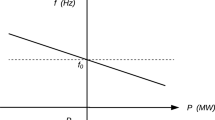Abstract.
An ever-increasing requirement to integrate greater amounts of electrical energy from renewable sources especially from wind turbines and solar photo-voltaic installations exists and recent experience in the island of Ireland demonstrates that this requirement influences the behaviour of conventional generating stations. One observation is the change in the electrical power output of synchronous generators following a transient disturbance especially their oscillatory behaviour accompanied by similar oscillatory behaviour of the grid frequency, both becoming more pronounced with reducing grid inertia. This behaviour cannot be reproduced with existing mathematical models indicating that an understanding of the behaviour of synchronous generators, subjected to various disturbances especially in a system with low inertia requires a new modelling technique. Thus two models of a generating station based on a double pendulum described by a system of coupled nonlinear differential equations and suitable for analysis of its stability corresponding to infinite or finite grid inertia are presented. Formal analytic solutions of the equations of motion are given and compared with numerical solutions. In particular the new finite grid model will allow one to identify limitations to the operational range of the synchronous generators used in conventional power generation and also to identify limits, such as the allowable Rate of Change of Frequency which is currently set to \(\pm 0.5\) Hz/s and is a major factor in describing the volatility of a grid as well as identifying requirements to the total inertia necessary, which is currently provided by conventional power generators only, thus allowing one to maximise the usage of grid connected non-synchronous generators, e.g., wind turbines and solar photo-voltaic installations.
Similar content being viewed by others
References
P. Kundur, Power system stability and control, in The EPRI Power System Engineering Series (McGraw Hill Inc., NY, 1994)
M. Zarifakis, W.T. Coffey, Impact of elevated Rate of Change of Frequency (RoCoF) on conventional power generation plant in the Island of Ireland, VGB PowerTech (8/2014)
M. Zarifakis, W.T. Coffey, Transient Stability of conventional power generating stations during times of high wind penetration, in Arbeitskreis Energie, Vortraege auf der DPG Fruehjahrstagung in Berlin 2015 (9/2015)
E.T. Whittaker, G.N. Watson, A Course of Modern Analysis, 4th edition (Cambridge University Press, London, 1927)
M. Abramowitz, I.A. Stegun (Editors), Handbook of Mathematical Functions (Dover, New York, 1972)
W.T. Coffey, Yu.P. Kalmykov, The Langevin Equation, 4th edition (World Scientific, Singapore, 2017)
H. Risken, The Fokker-Planck Equation, 2nd edition (Springer, Berlin, 1989)
Author information
Authors and Affiliations
Corresponding author
Rights and permissions
About this article
Cite this article
Zarifakis, M., Coffey, W.T., Kalmykov, Y.P. et al. Models for the transient stability of conventional power generating stations connected to low inertia systems. Eur. Phys. J. Plus 132, 289 (2017). https://doi.org/10.1140/epjp/i2017-11543-4
Received:
Accepted:
Published:
DOI: https://doi.org/10.1140/epjp/i2017-11543-4




